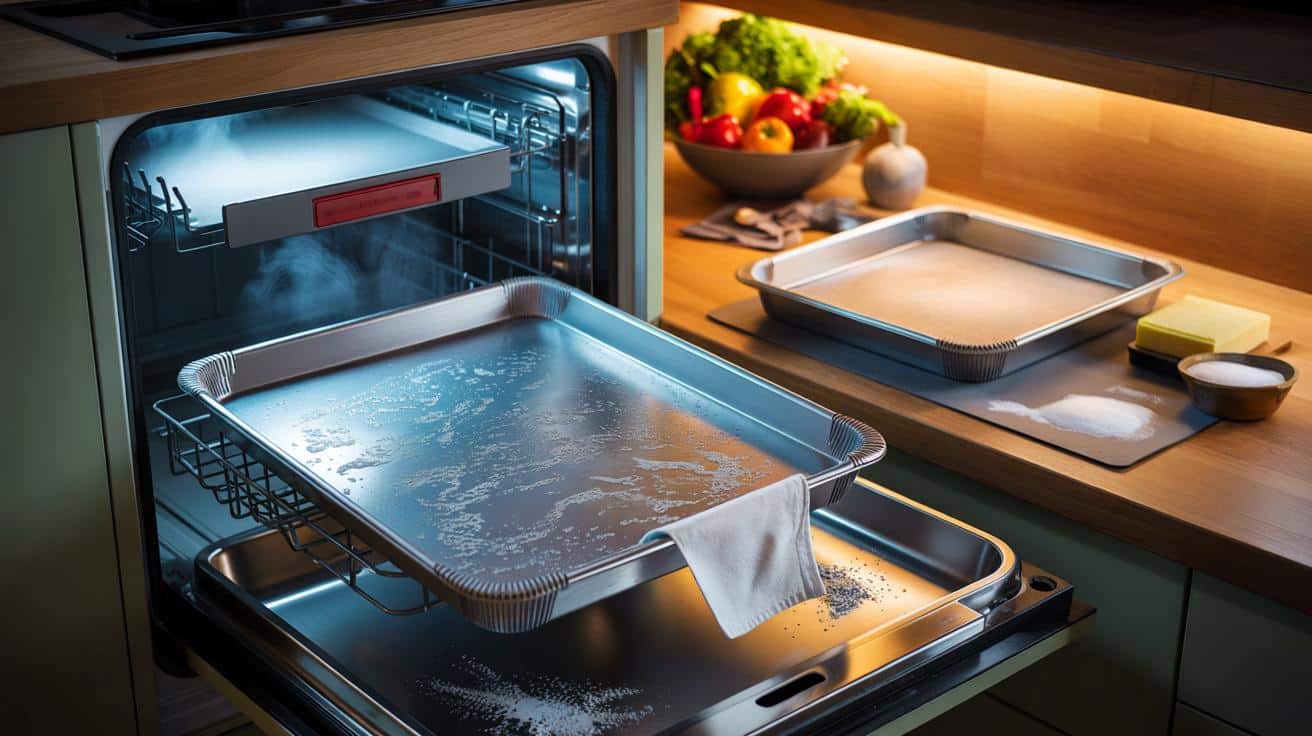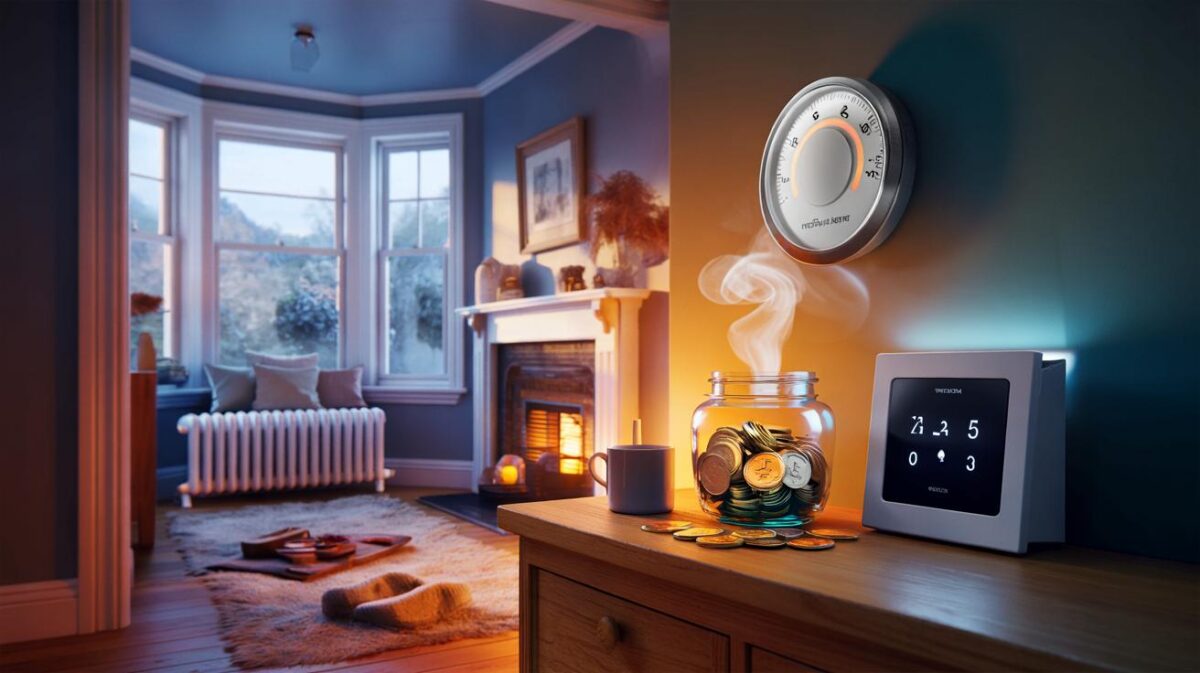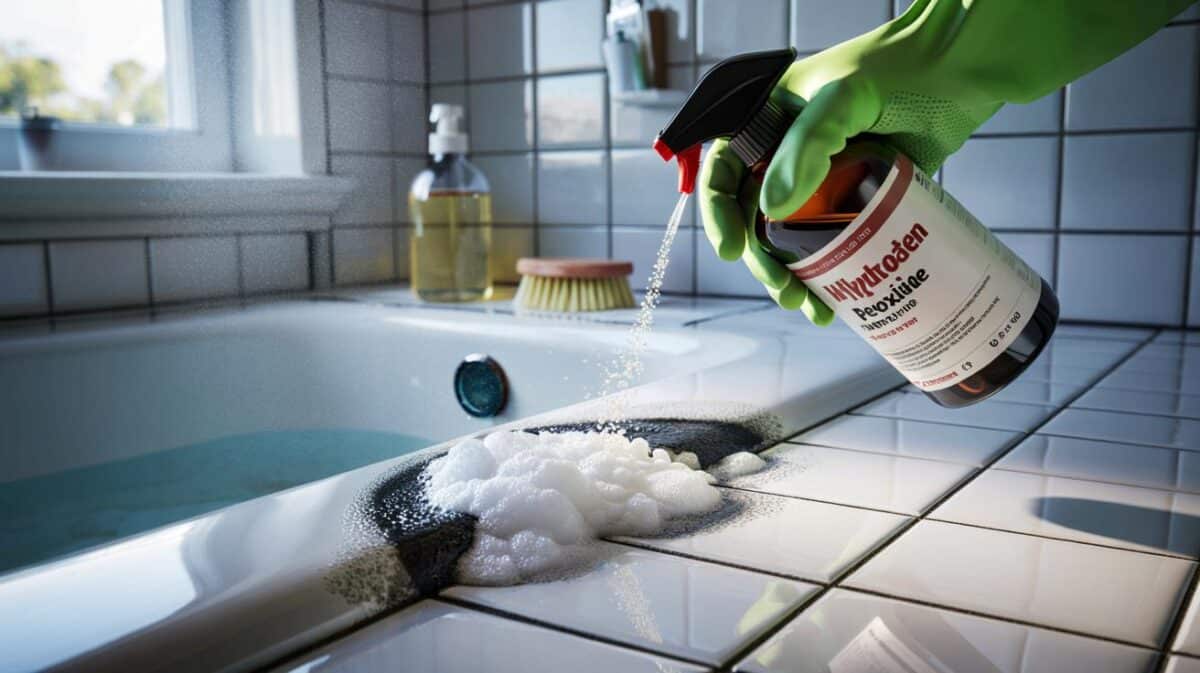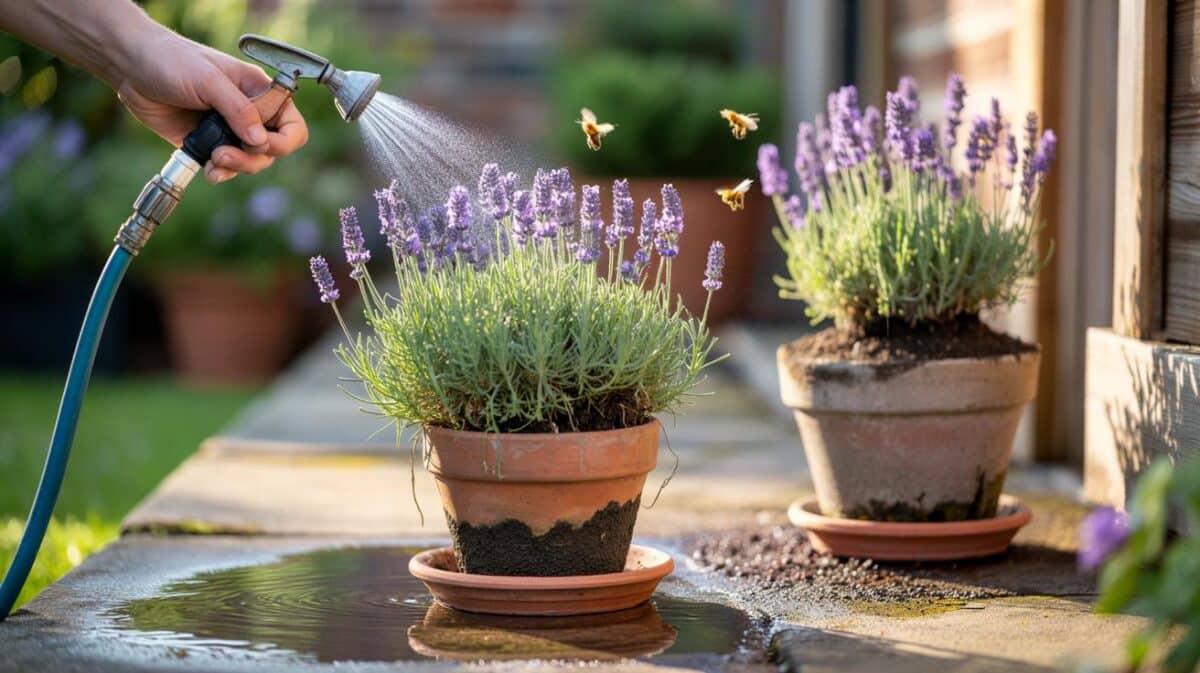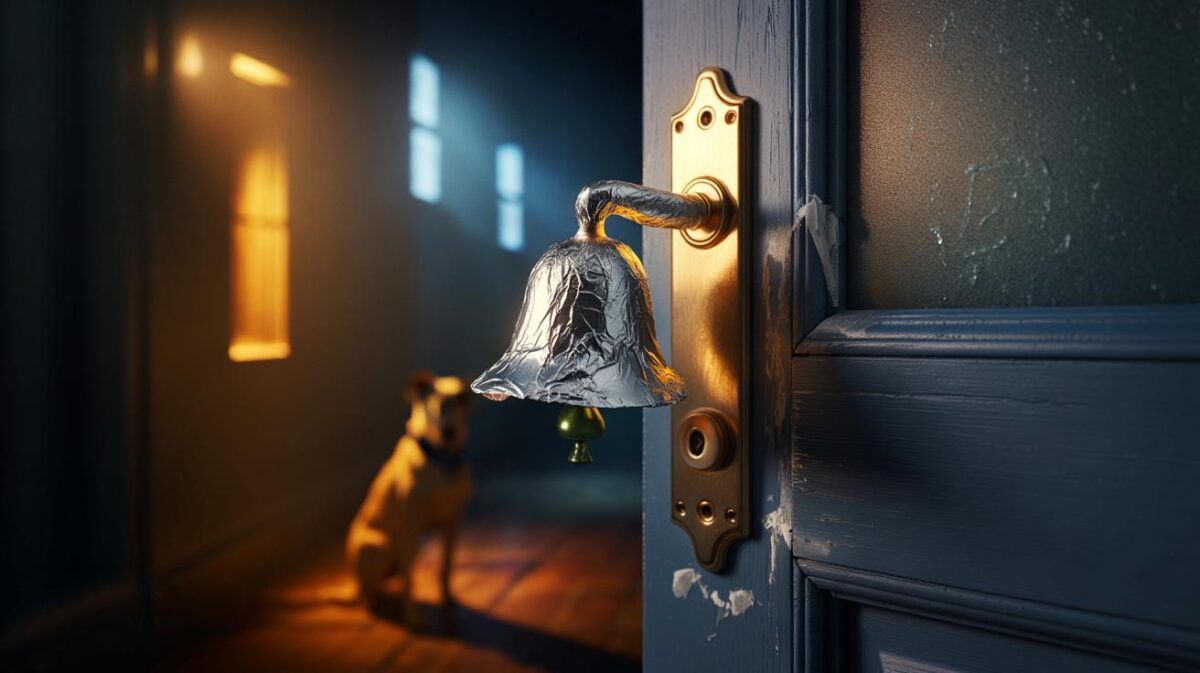Anything that looks grubby goes in, button pressed, door shut, job done. We’ve all had that moment when the kitchen is quiet, the counter is clear, and you feel smugly efficient. Then one everyday item comes out looking tired, scarred, oddly chalky. Not your cast iron. Not your knives. Something humbler — and far easier to ruin.
It was a weeknight, late, the kind of evening where the air smells faintly of roasted garlic and a cushiony sort of relief. A sheet-pan supper had done its job — chicken, peppers, the sticky corners of caramelised onion — and I dragged the browned tray to the dishwasher. No ceremony. Just a clatter, a rinse of the hands, lights off. In the morning, I pulled that same tray from the top rack and blinked. It had gone dull, patchy, rough to the touch. A grey bloom had spread like frost.
The tea towel caught black streaks. My fingers felt gritty, almost squeaky on the metal. Food still cooked on it, sure, but something essential had shifted. *It looked clean, but it was never the same.* I stared at the tray and thought of all the times I’d done this without a second thought. The culprit wasn’t the heat.
Meet the quiet casualty: your aluminium sheet pan
Of all the kitchen workhorses, bare aluminium baking trays and sheet pans are the ones you should never put in the dishwasher. Not what you think, right? They’re light, cheap, everywhere — and they do not play nicely with dishwasher chemistry. One full cycle can turn bright metal cloudy, raise a rough nap on the surface, and speckle it with tiny pits.
The truth shows up the next time you cook. Oil doesn’t spread evenly. Chips appear along the edges. Sometimes a grey smear transfers to a stack of flatbreads or to the palm of your hand. I’ve seen people blame “cheap pans” when it was the wash routine doing the damage. It’s not a moral failing. It’s chemistry.
Dishwasher detergents are highly alkaline — think pH 10–12 — engineered to blitz grease and clingy starch. That high pH attacks the thin oxide layer that protects bare aluminium. The long, hot cycle amplifies it, and the spray is like a miniature sandstorm, knocking at weaknesses. If your pan touches a different metal, say a stainless rack or another pot, you can even trigger tiny galvanic reactions that speed up the dulling and pitting. Once that surface is changed, it won’t gleam back to new. It’s a one-way street.
How to clean and care without the dishwasher
Skip the machine for bare aluminium. Do this instead: run the hot tap until it steams. Add a few drops of washing-up liquid to the pan, then flood it with the hot water. Let it sit for 10 minutes so the fond releases. Sprinkle a little bicarbonate of soda and work it with a soft sponge or nylon brush in circles. Rinse hot, dry straight away, then warm the pan for a minute on a low hob to banish lingering moisture.
Stubborn sticky sugar or roasted-on edges? Make a paste of bicarbonate of soda and a splash of water, leave it on for five minutes, then scrub. A little Bar Keepers Friend (oxalic acid) lifts that amber patina without chewing the metal. Wipe clean, rinse, then give the tray the thinnest film of neutral oil if you want to keep it slick. Let it cool, then stack with a tea towel between pans to avoid rub marks.
Let’s be honest: no one hand-washes sheet pans every single day. Life is busy, arms get tired, and the dishwasher door is right there. If you slip up, don’t panic; you can still cook on a dulled pan. The surface has changed, not your ability to roast potatoes. But make the slip-up your last. Keep tomato sauce, lemon juice, and vinegar off bare aluminium for long soaks, and don’t nest a wet tray under a heavy pot. **Hand-wash only** becomes a habit quicker than you think.
“A dishwasher is basically an alkaline steam bath under pressure,” said a London materials specialist I rang for sense-checking. “Bare aluminium hates that. It relies on a fragile oxide skin. Strip that, and you invite pitting, greying, and weird flavours. It’s not rust — it’s chemistry.”
- Choose stainless steel or hard-anodised trays if you want machine-safe options.
- Use parchment or a silicone mat to cut down scrubbing between cooks.
- For stained corners, try a bicarbonate paste before reaching for abrasives.
- Dry immediately; lingering droplets can mark and streak aluminium.
- Store with a cloth layer to avoid rub-wear and black smudges.
When damage is done — and what that says about our kitchens
The cloudy-grey finish isn’t dirt. It’s a surface change. You can restore some shine with an oxalic cleanser and patience, but you won’t get factory-fresh back. That’s alright. A lived-in tray still roasts brilliantly. The question is whether you want a pretty pan or a trusty one, and where the dishwasher fits in that balance.
There’s another angle here: cost and waste. Replacing trays every year because the machine eats them is the kind of quiet expense that sneaks past our budgets. One simple change — hand-washing bare aluminium — can keep your pans going for years. **High-pH detergents** aren’t villains; they’re just wrong for this job. Choosing the right tool for the wash is part of the cooking.
I’ve noticed something else, too. We outsource so much of our kitchen routine to hum and whirr behind a closed door, we forget which materials thrive on a quick human touch. **Bare aluminium** likes a moment of hot water and a soft sponge. Stainless will tolerate the big machine. Wood wants a wipe and air. What’s your cutlery drawer or baking cupboard quietly trying to tell you? I’d love to hear the rescue stories — and the heartbreaks we can help someone else avoid.
| Point clé | Détail | Intérêt pour le lecteur |
|---|---|---|
| Never machine-wash bare aluminium | Dishwasher alkalinity and heat strip the protective oxide, causing greying and pitting | Protects trays from premature ageing and off-putting residue |
| Know your metals | Stainless steel tolerates dishwashers; hard-anodised may survive; bare aluminium won’t | Prevents guesswork and saves money on replacements |
| Two-minute clean-up | Hot water + washing-up liquid soak, bicarbonate scrub, quick dry and optional light oil | Low effort routine that keeps pans slick and dependable |
FAQ :
- Is my “dishwasher-safe” aluminium pan actually safe in the machine?Marketing labels vary. Hard-anodised aluminium can handle more abuse than bare metal, and some coated trays claim machine tolerance. The shine can still dull and edges can pit over time. If it’s bare or brushed aluminium, keep it out.
- Can I fix a grey, chalky aluminium tray after one bad wash?You can improve it. Use an oxalic-acid cleaner like Bar Keepers Friend with a non-scratch sponge, working in small circles. Rinse hot, dry, and accept that the finish may remain matte. It will still cook well.
- Why did my pan leave black marks on a cloth after the dishwasher?The alkaline detergent likely lifted the oxide layer, exposing reactive aluminium that sheds a grey-black residue. Hand-wash a few times, dry thoroughly, and the shedding usually settles as a new oxide patina forms.
- Should I switch to stainless steel sheet pans if I love my dishwasher?Yes. Stainless half sheets cost more, but they tolerate machine cycles, hold their shine better, and don’t smear. They run a touch heavier, and heat a little differently, but they’re great for everyday roasting.
- Are there other items I should keep out of the dishwasher?Yes: carbon steel and cast iron, razor-sharp knives, wooden boards and utensils, insulated travel mugs with vacuum seals, and pepper mills. Different reasons, same outcome — a shorter, sadder life than you planned.

